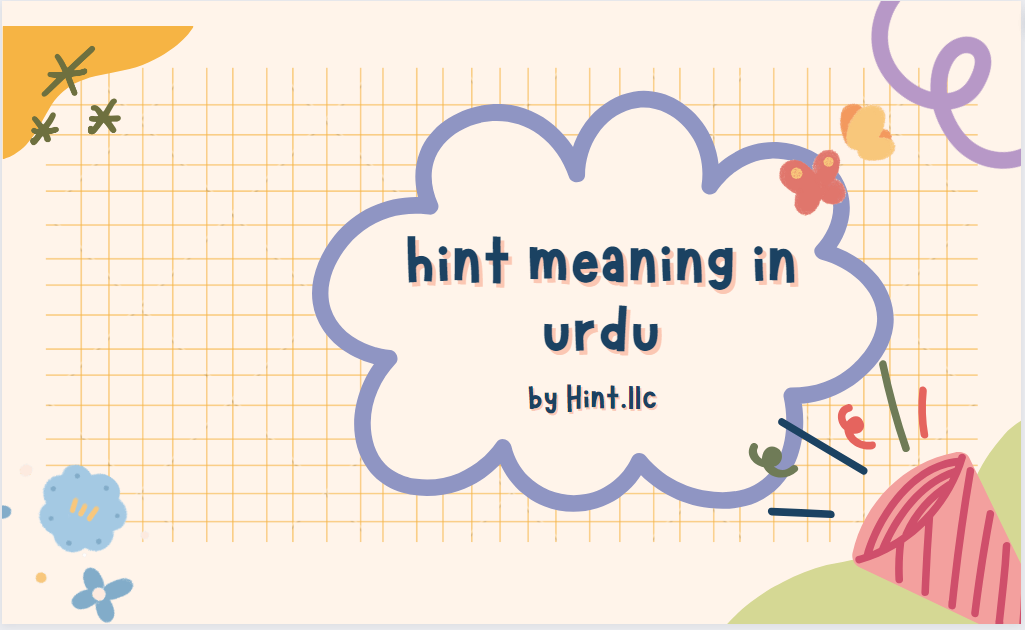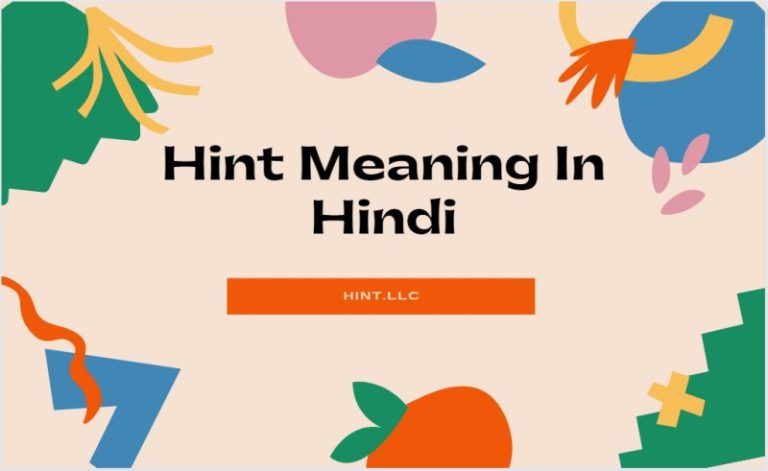hint meaning in Urdu
“Have you ever found yourself in a situation where someone drops a subtle hint, leaving you puzzled and uncertain about its intended meaning? Such instances are not uncommon, especially when it comes to understanding cultural terms like ‘hint’ in different languages. We examine Urdu’s interesting world of “hint” in this essay. Join us on this captivating journey as we explore the multifaceted nature of ‘hint,’ unravel its linguistic and cultural dimensions, and equip ourselves with the knowledge to decipher its significance. Understanding the true essence of ‘hint’ in Urdu is not just about language; it is about embracing the culture and fostering effective communication across borders.”
Unveiling the Concept of “Hint” in Urdu
The full meaning of “hint” in Urdu must be revealed to understand it.”Hint” is a term that holds significant value in the Urdu language, encompassing a range of subtle implications and indirect communication techniques. This article aims to shed light on this intriguing concept, offering a deeper understanding of what “hint” truly signifies in Urdu-speaking communities. By exploring its linguistic origins, pronunciation intricacies, and transliteration challenges, we can unravel the essence of “hint” and its unique place in the Urdu language. Prepare to embark on a journey of discovery, as we unravel the concept of “hint” and uncover its cultural significance.
The Cultural Significance of “Hint” in Urdu
The cultural significance of “hint” in Urdu is a fascinating aspect that highlights the intricate social dynamics and communication styles within Urdu-speaking communities. By using subtle cues and non-verbal expressions, individuals convey messages that go beyond the literal interpretation of words. Understanding the cultural nuances associated with “hint” is crucial for effective communication and social interactions. Let’s explore three subheadings to delve deeper into the cultural significance of “hint” in Urdu:
Interpreting Non-Verbal Communication:
In Urdu culture, non-verbal communication plays a vital role in hinting. Gestures, body language, facial expressions, and eye contact can convey hidden meanings that words alone may not express. We will uncover the significance of these non-verbal cues and how they contribute to the art of hinting in Urdu-speaking communities.
Social Context and Implicit Communication:
The usage of “hint” in Urdu is deeply rooted in social contexts and implicit communication. Different settings, such as professional environments, personal relationships, and educational settings, have their own unwritten rules when it comes to hinting. We will explore the social norms, etiquette, and implicit communication styles associated with “hint” in these various contexts.
Cultural Implications and Taboos:
“Hint” in Urdu is influenced by cultural beliefs, values, and taboos. Understanding these cultural implications is essential to avoid misinterpretation or causing offense. We will delve into the cultural dimensions of “hint” in Urdu, exploring how certain symbols, metaphors, and indirect expressions are deeply ingrained in the language and carry specific meanings within the cultural context.
We’ll learn about Urdu’s cultural importance of “hint” and how it affects communication and social relationships by investigating these subheadings.
Understanding the Various Dimensions of “Hint” in Urdu
To fully understand “hint” in Urdu, one must examine its multidimensional nature and how it manifests in diverse circumstances. By evaluating its contextual usage and distinguishing it from direct communication, we may appreciate its intricacies. Let’s explore three subheadings that illuminate “hint” in Urdu:
Contextual Usage:
Urdu uses “hint” in several contexts. Its use in professional, personal, and educational settings should be examined. Understanding the situations in which “hint” is used helps us appreciate its importance and impact on communication in various fields.
Differentiating “Hint” from Direct Communication:
In Urdu, “hint” stands in contrast to direct communication. It embodies subtlety, politeness, and implication rather than explicitness. By exploring the nuances that differentiate “hint” from direct communication, such as the role of politeness, subtlety, and cultural context, we can decipher its unique characteristics and appreciate its importance in Urdu language and culture.
Cultural Context and Expectations:
“Hint” in Urdu is deeply rooted in cultural context and expectations. It is shaped by societal norms, values, and cultural intricacies. By examining the cultural dimensions associated with “hint,” we can gain insights into the unspoken rules, implicit meanings, and cultural expectations that underpin its usage. This exploration will help us navigate the cultural nuances and comprehend the intricate interplay between language and culture in hinting.
By examining these subheadings, we can gain a comprehensive understanding of the various dimensions of “hint” in Urdu. We will explore its contextual usage, differentiate it from direct communication, and delve into the cultural context and expectations that shape its meaning and significance.
Learning to Decipher “Hint” in Urdu
Learning to decipher the art of “hint” in Urdu is a captivating journey that involves developing a keen sense of observation and cultural sensitivity. To unlock the hidden meanings and implications behind hints in Urdu, one must recognize common scenarios where hints are commonly employed, such as workplace dynamics, romantic relationships, and social gatherings. By immersing oneself in these contexts, individuals can become attuned to the subtle verbal and non-verbal cues that signify a hint being conveyed.
Decoding hints in Urdu requires a deep understanding of the nuances of tone, inflection, and choice of words, as well as the ability to read between the lines and recognize implied messages. It also involves being mindful of the cultural context and the specific cultural cues that may accompany hints in Urdu. By honing these skills and actively engaging in conversations and interactions, individuals can enhance their ability to decipher hints in Urdu and navigate the rich tapestry of implicit communication within Urdu-speaking communities.
Learning to Decipher “Hint” in Urdu
Mastering the skill of hinting in Urdu is an art that requires finesse, intuition, and a deep understanding of cultural nuances.
To become adept at hinting, individuals must develop sensitivity and awareness towards subtle cues and indirect communication. The art lies in finding the delicate balance between conveying a message indirectly and ensuring it is understood by the intended recipient. Effective strategies for hinting in Urdu involve using subtle language choices, employing indirect questions, and utilizing figurative language to convey meaning. It is essential to recognize the appropriate timing and context for hinting, as well as the preferences and communication styles of the individuals involved.
By honing this skill, individuals can navigate complex social dynamics, convey messages tactfully, and build stronger connections within Urdu-speaking communities. Mastering the art of hinting not only enhances one’s communication abilities but also deepens cultural understanding and fosters more harmonious interactions in Urdu-speaking contexts.
Navigating Challenges in Interpreting “Hint”
Navigating the challenges in interpreting “hint” in Urdu requires a keen awareness of the cultural differences and potential misunderstandings that may arise. Cross-cultural communication barriers can pose challenges when it comes to understanding hints in Urdu, as individuals from different cultural backgrounds may have different interpretations and expectations.
It is important to be mindful of stereotypes and assumptions that can hinder accurate interpretation. Overcoming these challenges involves active listening, seeking clarification when needed, and approaching conversations with cultural sensitivity. It is crucial to be open-minded and willing to learn about the cultural nuances associated with hinting in Urdu, allowing for effective communication and avoiding misunderstandings.
By navigating these challenges, individuals can bridge cultural gaps, promote mutual understanding, and establish stronger connections within Urdu-speaking communities.
Places where hint word use
The word “hint” is commonly used in various contexts where individuals aim to imply or suggest something indirectly. Here are a few places where the word “hint” is often utilized:
Conversations: During conversations, people may drop hints to convey a message or steer the discussion in a particular direction without being too explicit.
Relationships: In personal relationships, hints can be used to express desires, expectations, or concerns without directly stating them. Partners may drop hints to communicate their needs or express affection.
Work Environments: In professional settings, hints can be employed to provide suggestions, offer feedback, or convey ideas without being too forceful or authoritative. Colleagues and supervisors may use hints to guide others towards certain actions or decisions.
Creative Writing: Hints are often used in storytelling, literature, and mysteries to create suspense, intrigue, and engage the readers. Authors drop hints to foreshadow events or encourage readers to draw their own conclusions.
Treasure Hunts or Games: In recreational activities like treasure hunts or riddles, hints are given to help participants solve puzzles or find hidden objects. These hints provide clues and guidance without giving away the solution directly.
Teaching and Learning: Educators may use hints to facilitate student learning. Hints can steer students in the right direction, encourage critical thinking, and prompt them to explore solutions independently.
Problem-Solving Scenarios: Hints can be employed in problem-solving situations, such as puzzles, brainteasers, or escape rooms. They offer subtle guidance to assist individuals in finding solutions without explicitly revealing the answers.
These are just a few examples of places where the word “hint” finds its usage. The purpose of using hints in these contexts is to convey information indirectly, encourage engagement, or spark curiosity while allowing individuals to explore and interpret the intended message.
People Also Ask (FAQs)
What does “hint” mean in Urdu?
“Hint” in Urdu refers to a subtle clue, suggestion, or indication that is conveyed indirectly rather than explicitly. It involves using non-verbal cues, implied messages, or subtle language choices to convey meaning.
How can I understand hints in Urdu conversations?
Understanding hints in Urdu conversations requires attentiveness to verbal and non-verbal cues. It involves observing body language, tone, context, and cultural nuances. Active listening and familiarity with common hint scenarios can help in deciphering the intended message.
Are hints culturally specific to the Urdu language and culture?
While hinting exists in various cultures, the specific expressions, gestures, and subtleties of hints can vary across languages and cultures. In the context of the Urdu language and culture, hints carry their own unique nuances and social expectations.
What are some common situations where hints are used in Urdu-speaking communities?
Hints are commonly employed in various scenarios in Urdu-speaking communities, such as personal relationships, workplace dynamics, social gatherings, and creative expressions like poetry. They serve as a means of conveying messages indirectly and fostering effective communication.
How can I improve my ability to give and understand hints in Urdu?
Improving the ability to give and understand hints in Urdu involves actively engaging in conversations, observing cultural norms and practices, and seeking exposure to the language and culture through immersion or interaction with native speakers. Practicing active listening and being receptive to subtle cues can also enhance hinting skills.
Can hints sometimes lead to misunderstandings?
Yes, hints can occasionally lead to misunderstandings, especially when cultural contexts, individual interpretations, or expectations differ. It is important to clarify and seek further explanation if the hint is not clear or if there is uncertainty about its intended meaning.
Are there any cultural taboos or sensitivities related to hinting in Urdu?
Yes, certain cultural taboos and sensitivities exist regarding hinting in Urdu. It is essential to be mindful of cultural norms, and social hierarchies, and respect boundaries when using or interpreting hints to avoid unintentional offense or miscommunication.
conclusion
Exploring the meaning and cultural significance of “hint” in Urdu reveals a rich tapestry of subtle communication techniques and implicit messages. The art of hinting in Urdu involves navigating non-verbal cues, recognizing contextual usage, and understanding the interplay between language and culture. By mastering the skill of deciphering hints, individuals can foster effective communication, build stronger connections, and navigate complex social dynamics within Urdu-speaking communities. It is crucial to approach hinting with cultural sensitivity, active listening, and a willingness to learn and adapt to different contexts. As we unravel the mysteries of hinting in Urdu, we gain a deeper understanding of the intricate layers of communication and the beauty of subtle expressions that transcend mere words. Embracing the art of hinting in Urdu enriches our cultural experiences, fosters meaningful connections, and allows for more nuanced and harmonious interactions in the Urdu-speaking world.







